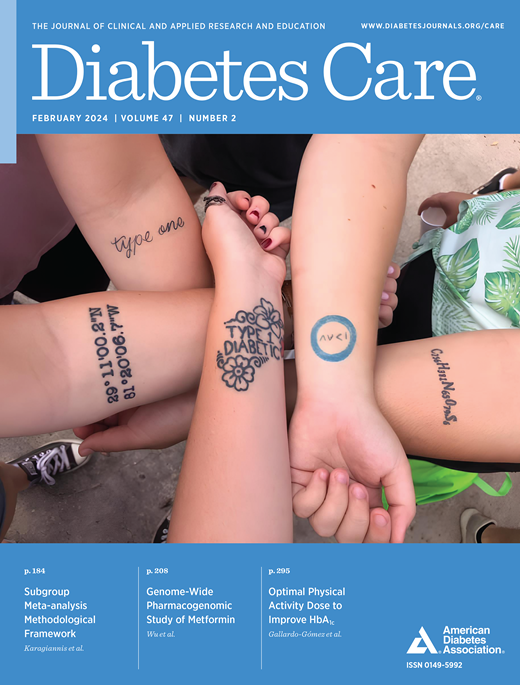Plant-Based Dietary Patterns Associated With Reduced Risk of All-Cause Mortality in Diabetes Subgroups: A Prospective Cohort Study From the UK Biobank
IF 16.6
1区 医学
Q1 ENDOCRINOLOGY & METABOLISM
引用次数: 0
Abstract
OBJECTIVE To investigate the association between adherence to a plant-based dietary index (PDI), healthy PDI, and unhealthy PDI with all-cause mortality in people with type 2 diabetes and to assess whether associations varied by diabetes subgroups. RESEARCH DESIGN AND METHODS We included 4,829 UK Biobank participants with type 2 diabetes and at least two 24-h dietary recalls. We generated overall, healthy, and unhealthy scores. Multivariable Cox regression estimated hazard ratios (HRs) and 95% CIs for all-cause mortality, comparing the highest tertile (T3) with the lowest T1 of adherence to PDI, a healthy PDI, and an unhealthy PDI. Interactions between PDI adherence and diabetes subgroups (HbA1c, waist circumference, age at diagnosis, diabetes duration) were assessed by two-dimensional B-splines and by including product terms into the model. RESULTS During a mean follow-up of 11.3 years, 679 deaths occurred. Individuals with the highest PDI adherence, compared with those with lowest, were at lower risk of all-cause mortality (T3 vs. T1: HR 0.79 [95% CI 0.63; 0.99]), and a similar direction was observed for those with a healthy PDI (0.82 [0.67; 1.02]) but the 95% CI included the null value. Unhealthy PDI was associated with increased mortality risk (1.24 [1.00; 1.54]). The associations of PDI, healthy PDI, and unhealthy PDI with all-cause mortality risk were more pronounced for those with poorer glycemic control, higher waist circumference, diagnosis earlier in life, and longer diabetes duration. CONCLUSIONS Higher PDI adherence was associated with decreased mortality risk and higher unhealthy PDI adherence with an increased mortality risk. There was an indication for differences in these association depending on diabetes subgroups.植物性饮食模式与糖尿病亚组全因死亡率降低相关:来自英国生物银行的前瞻性队列研究
目的研究坚持植物性饮食指数(PDI)、健康PDI和不健康PDI与2型糖尿病患者全因死亡率之间的关系,并评估这种关系是否因糖尿病亚组而异。研究设计和方法我们纳入了4829名英国生物银行参与者,他们患有2型糖尿病,并且至少有两次24小时饮食回顾。我们生成了总体、健康和不健康的分数。多变量Cox回归估计了全因死亡率的风险比(hr)和95% ci,比较了坚持PDI、健康PDI和不健康PDI的最高终点(T3)和最低终点(T1)。PDI依从性与糖尿病亚组(HbA1c、腰围、诊断时年龄、糖尿病持续时间)之间的相互作用通过二维b样条和将产品项纳入模型来评估。结果:在平均11.3年的随访期间,发生679例死亡。与PDI依从性最低的个体相比,PDI依从性最高的个体全因死亡风险较低(T3 vs. T1: HR 0.79 [95% CI 0.63; 0.99]), PDI健康的个体也有类似的趋势(0.82[0.67;1.02]),但95% CI包括零值。不健康的PDI与死亡风险增加相关(1.24[1.00;1.54])。PDI、健康PDI和不健康PDI与全因死亡风险的关联在血糖控制较差、腰围较高、生命早期诊断和糖尿病病程较长的患者中更为明显。结论:较高的PDI依从性与死亡风险降低有关,而较高的不健康PDI依从性与死亡风险增加有关。有迹象表明,根据糖尿病亚组,这些关联存在差异。
本文章由计算机程序翻译,如有差异,请以英文原文为准。
求助全文
约1分钟内获得全文
求助全文
来源期刊

Diabetes Care
医学-内分泌学与代谢
CiteScore
27.80
自引率
4.90%
发文量
449
审稿时长
1 months
期刊介绍:
The journal's overarching mission can be captured by the simple word "Care," reflecting its commitment to enhancing patient well-being. Diabetes Care aims to support better patient care by addressing the comprehensive needs of healthcare professionals dedicated to managing diabetes.
Diabetes Care serves as a valuable resource for healthcare practitioners, aiming to advance knowledge, foster research, and improve diabetes management. The journal publishes original research across various categories, including Clinical Care, Education, Nutrition, Psychosocial Research, Epidemiology, Health Services Research, Emerging Treatments and Technologies, Pathophysiology, Complications, and Cardiovascular and Metabolic Risk. Additionally, Diabetes Care features ADA statements, consensus reports, review articles, letters to the editor, and health/medical news, appealing to a diverse audience of physicians, researchers, psychologists, educators, and other healthcare professionals.
 求助内容:
求助内容: 应助结果提醒方式:
应助结果提醒方式:


